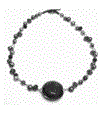 2) Rina is making a necklace using 3 different colors of beads, Red, White and Blue, and a center stone. How many ways can she string 4 beads using all 3 colors of beads?
2) Rina is making a necklace using 3 different colors of beads, Red, White and Blue, and a center stone. How many ways can she string 4 beads using all 3 colors of beads?
Note: Consider that two beads of the same color are interchangeable and don't count as 2 separate combinations
|
The wording of this problem is tricky. What it means is that you can duplicate each color to make 4 choices.
Use R for red, W for white and B for blue.
So your 3 choices are:
2 reds, 1 white, 1 blue (R R W B)
2 whites, 1 red, 1 blue (W W R B)
2 blues, 1 red, 1 white (B B R W)
There are 2 ways to approach this problem.
Method 1:List the possibilities for RRWB and then multiply by 3.
List all the possibilities for the first option containing 2 reds. Remember that the two red beads are the same and that a combination of R1 R2 W B is the same as R2 R1 W B.
Two reds:
R R W B
R R B W
R B R W
R B W R
R W R B
R W B R
W R R B
W R B R
W B R R
B R R W
B R W R
B W R R
This is 12 combinations.
Multiply this by 3 (to get the 2 whites and the 2 blues combinations) to get the total number of color combinations =
12 x 3 = 36
Method 2: Use the formula for permutations of words with repeated letters. This is the same problem, except we have beads instead of words.
This formula is :
P = n! / r! where:
n = the number of colors (the exclamation point means to take the factorial of n.)
r = the number of repeated colors (again, factorial)
Once you have this number, multiply by 3 because you can duplicate each of the 3 colors.
P = 4! / 2! = 24/2 = 12.
Multiply by 3 to get the total for all 3 colors = 3 x 12 = 36.
The number of combinations is 36
|